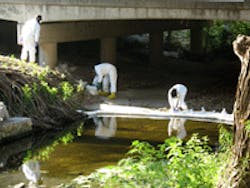AHMP Emergency Response Simulation Shows Importance of Communication, Preparedness
The simulation used non-hazardous dye to represent waste oil. Three drums of this “oil” fell from a truck and spilled in Waller Creek, which runs from the north side of the UT Austin campus to Lady Bird Lake and, ultimately, the Colorado River. Calhoun stressed that in an actual response scenario, this highly hazardous, highly flammable substance could enter the watershed very quickly, especially if the creek was moving at rapid speeds.
“It’s important for groups to exercise this,” Calhoun explained. “You can never really create the real thing, but I think it was a true testament to the program that they had [everything] in line and were able to communicate and follow their process without any hitches.”
Multiple entities responded to the simulated crisis, including UT’s emergency response team, UT’s campus police and fire department and Austin’s fire department and police department. Responders assessed the material that had spilled, put down boom and worked to stop the flow. Calhoun pointed out that the response also included cleanup operations as part of the demonstration even though the dye would not cause any harm to the environment or the public.
“They actually gathered some of the dye and showed the participants how they removed it from the water and then contained it in a drum for later disposal,” Calhoun explained. “Our group appreciated seeing [the demonstration come] full circle.”
Be Prepared
Approximately 35 professionals from private industry, EHS departments, universities or government agencies watched the demonstration, which was part of AHMP’s annual national conference. Calhoun called the response “incredible” and especially praised “the fact that the communication structure was so tight and that [responders] had a plan that they were able to execute.”
Responders communicated via pagers, text messages and 14 radio signals. In an emergency response situation like this one, Calhoun pointed out, “You can’t just get on the horn and call someone. You’ve got to think and look at the technology and interoperability to maximize your region in a very short period of time.”
Overall, Calhoun said that the simulation’s most important message was simple: Be prepared.
“What we preach more than anything else is, frankly, preparedness,” Calhoun said. “We want [preparedness] to be part of everyone’s normal day. The big take-away for folks is just to be prepared, and be prepared now. Not prepare a week from now, a month from now, a year from now. Prepare yourself, your family and business now.”
About the Author

Laura Walter
Laura Walter was formerly senior editor of EHS Today. She is a subject matter expert in EHS compliance and government issues and has covered a variety of topics relating to occupational safety and health. Her writing has earned awards from the American Society of Business Publication Editors (ASBPE), the Trade Association Business Publications International (TABPI) and APEX Awards for Publication Excellence. Her debut novel, Body of Stars (Dutton) was published in 2021.
